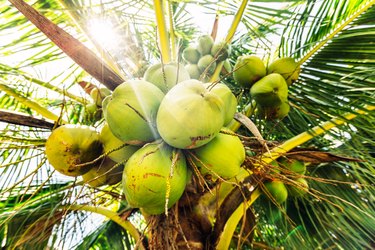
When we think about Florida, there's a certain mood associated with the state: warm, beautiful and tropical settings with nice beaches and palm trees swaying in the breeze. In fact, the palm trees and palm tree fruit might be one of the best things about Florida. This is especially true of coconut palms, which produce coconuts that provide a number of products, from moisturizing oils to coconut water. Coconuts are ripe in Florida based on the life span of the tree rather than a specific time of year.
Coconut Palm Tree Fruit
Video of the Day
The coconut palm (Cocos nucifera, USDA plant hardiness zones 10 and 11) is the most economically important palm, as nearly every piece of the coconut can be used as a product somewhere. They're believed to have originated in the South Pacific, or the Malay Archipelago, but because coconuts can float for a very long time and still germinate new trees at the end of the journey, it's hard for scientists to tell. Coconut trees will produce fruit until they are 80 years old, producing 50 to 200 coconuts per tree every year.
Video of the Day
This palm tree fruits by producing coconuts that are around 12 inches in diameter. These consist of the thick white meat inside the husks, which is pressed to produce coconut oil and copra, and the water inside the husk, which can be an attractive product for drinking.
When Are Coconuts Harvested?
Peak harvesting time for products like coconut oil or water is different within the time scale of the coconut's growth and ripening. Coconuts ripen slowly over the course of 12 months from fruit set.
The harvesting of coconuts in Florida actually occurs throughout the year since different trees will flower at different times. Florida's climate is such that plants do not only ripen at certain times of the year, as is the case in some of the colder USDA plant hardiness zones.
If you're looking to harvest coconuts for the water inside, you'll want to harvest them when they are around seven months old because as the fruit continues ripening, the water inside is consumed by the growing white meat. Coconuts will fall from the tree when they are fully ripe, meaning most coconuts on the ground are ready to be harvested. Some varieties of coconut will continue to ripen after falling or being picked.
Determining Whether a Coconut Is Ripe
There are a number of things you can check to see if a coconut is ripe, the most obvious one being the color. Immature coconuts start out as bright green fruits and ripen to that familiar hairy brown shell as they mature. While it's hard to gauge intermediate stages of ripeness simply from color, if the husk isn't entirely brown, the coconut isn't yet ripe.
If you can get a hold of the fruit, you can shake it to get a measure of ripeness. If you hear a lot of water sloshing around inside the nut, you have an immature coconut, but you can still crack it open and drink the coconut water inside. If there's some audible liquid sloshing around but it's quieter, you have a coconut that's in a stage where its meat will be soft enough to eat with a spoon, with a bit of water left over. If the nut sounds dry and hollow, you have a fully matured coconut.
The easiest way to harvest coconuts is to wait until they fall from the tree and pick them up from the ground. That said, immature fruits can fall for a variety of reasons as well. If it's one of the varieties of coconut that has been bred to a dwarf or pygmy size, you may be able to reach the coconuts yourself to evaluate them by moving them gently or knocking on the outside with a knuckle. Otherwise, you're going to need a very long set of pole pruners, a bucket truck or the patience to wait until they fall.